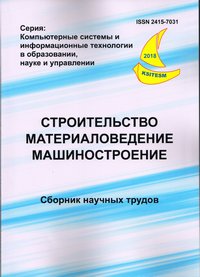Optimization of distribution of educational loads of teachers of chair
DOI:
https://doi.org/10.30838/P.CMM.2415.270818.73.233Keywords:
training load, Boolean optimization, multi-extremal problems, exact quadratic regularization, primer-dual interior point methodAbstract
Purpose. In the work the system of distribution of educational load among teachers of the department is considered. To ensure the quality of education, this task should be solved in an optimal way. The aim of the work is to develop a new optimization model for this task. This model is simpler than existing ones and adequately reflects the process of distribution of the training load. The resulting mathematical model is linear with Boolean variables. Methodology. In this paper, we propose to transform the model considered by means of exact quadratic regularization to the maximization of the Euclidean norm of a vector on a convex set. To solve the transformed problem, an effective direct-dual method of the interior point is used. Findings. A new technique is proposed for solving the load distribution problems of the teachers of the department on the basis of constructing an optimization model and using the effective method of exact quadratic regularization. This technique is implemented in the form of the corresponding software. Originality. A new methodology for solving complex optimization problems that arise in the process of modeling and optimizing the tasks of distribution of the teaching load among the teachers of the department is developed. Practical value. The considered methodology for solving complex optimization problems is implemented in the form of software. Comparative experiments confirm the effectiveness of this technique in solving the tasks of distributing the load of teachers of the departmentReferences
Kosolap A. I. Globalnaya optimizatsiya. Metod tochnoy kvadratichnoy regulyarizatsii [Global optimization. A method of exact quadratic regularization]. Dnipropetrovs’k, PGASA [PSАES], 2015, 164 p. (in Russian).
Nesterenkov C.N. Matematicheskaya model optimalnogo raspredeleniya chasov nagruzki kafedry mezhdu prepodavatelskim sostavom [Mathematical model of the optimal distribution of the load hours of the department between the teaching staff]. Doklady BGUIR, 2013, no. 6(76), pp. 42 - 46. (in Russian).
Sultanova C.N. and Tarchov C.V. Modeli i algoritmy podderzhki prinyatiya recheniy pri raspredelenii uchebnoy nagruzki prepodavateley [Models and algorithms for decision support in the distribution of teaching load of teachers]. Vesnik UGATU, 2006, t. 7, no. 3(16), pp. 107 - 114. (in Russian).
Tarchov C.V. and Sultanova C.N. Matematicheskaya model raspredeleniya uchebnoy nagruzki mezhdu prepodavatelyami kafedry [Mathematical model of the distribution of academic load among teachers of the department] Informazionnue technologii modelirovaniya i upravleniy. Voroneg, Nauchnay kniga, 2005, pp. 676 - 682. (in Russian).
Kenneth, V.P., Storn R.M.and Lampinen J.A. Differential Evolution. A Practical Approach to Global Optimization. Berlin Heidelberg, Springer-Verlag, 2005, 542 p.
Nocedal, J. and Wright S. J. Numerical optimization. Springer, 2006, 685 p.
Downloads
Published
Issue
Section
License
Редакція Видання категорично засуджує прояви плагіату в статтях та вживає всіх можливих заходів для його недопущення. Плагіат розглядається як форма порушення авторських прав і наукової етики.
При виявлені у статті більш ніж 25% запозиченого тексту без відповідних посилань та використання лапок, стаття кваліфікується як така, що містить плагіат. У цьому випадку стаття більше не розглядається редакцією, а автор отримує перше попередження.
Автори, в статтях яких повторно виявлено плагіат, не зможуть публікуватися в усіх журналах Видавництва ДВНЗ «Придніпровська державна академія будівництва та архітектури».
Автори, які публікуються у цьому журналі, погоджуються з наступними умовами:
- Автори залишають за собою право на авторство своєї роботи та передають журналу право першої публікації цієї роботи на умовах ліцензії Creative Commons Attribution License, котра дозволяє іншим особам вільно розповсюджувати опубліковану роботу з обов'язковим посиланням на авторів оригінальної роботи та першу публікацію роботи у цьому журналі.
- Автори мають право укладати самостійні додаткові угоди щодо неексклюзивного розповсюдження роботи у тому вигляді, в якому вона була опублікована цим журналом (наприклад, розміщувати роботу в електронному сховищі установи або публікувати у складі монографії), за умови збереження посилання на першу публікацію роботи у цьому журналі.
- Політика журналу дозволяє і заохочує розміщення авторами в мережі Інтернет (наприклад, у сховищах установ або на особистих веб-сайтах) рукопису роботи, як до подання цього рукопису до редакції, так і під час його редакційного опрацювання, оскільки це сприяє виникненню продуктивної наукової дискусії та позитивно позначається на оперативності та динаміці цитування опублікованої роботи (див. The Effect of Open Access).

